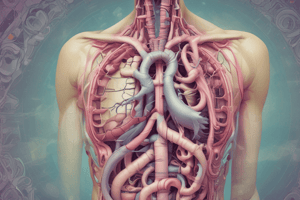Podcast
Questions and Answers
What are the two main categories of causes for oropharyngeal motor dysphagia?
What are the two main categories of causes for oropharyngeal motor dysphagia?
The two main categories of causes for oropharyngeal motor dysphagia are neurological disorders and neuromuscular junction diseases.
What are three examples of intrinsic narrowing of the esophagus?
What are three examples of intrinsic narrowing of the esophagus?
Three examples of intrinsic narrowing of the esophagus are inflammatory infections, webs or rings, and benign strictures.
What are two common symptoms of achalasia?
What are two common symptoms of achalasia?
Two common symptoms of achalasia are progressive dysphagia and chest pain.
What is a common clue that suggests mechanical obstruction in the esophagus?
What is a common clue that suggests mechanical obstruction in the esophagus?
What are three possible causes of extrinsic compression of the esophagus?
What are three possible causes of extrinsic compression of the esophagus?
What are the three main symptoms that strongly suggest a primary esophageal disorder?
What are the three main symptoms that strongly suggest a primary esophageal disorder?
What is the medical term for the feeling of burning in the chest that often radiates to the neck, and what is the cause?
What is the medical term for the feeling of burning in the chest that often radiates to the neck, and what is the cause?
Explain the two main types of dysphagia, and where the difficulties occur.
Explain the two main types of dysphagia, and where the difficulties occur.
What type of dysphagia would a patient with a history of stroke (CVA) likely experience, and why?
What type of dysphagia would a patient with a history of stroke (CVA) likely experience, and why?
What is aphagia, and why is it considered a medical emergency?
What is aphagia, and why is it considered a medical emergency?
List three different types of esophagitis that can contribute to dysphagia.
List three different types of esophagitis that can contribute to dysphagia.
Besides difficulties with swallowing, what other symptom can result from regurgitation of esophageal or gastric contents into the mouth?
Besides difficulties with swallowing, what other symptom can result from regurgitation of esophageal or gastric contents into the mouth?
Name two potential causes of non-cardiac chest pain that originate in the esophagus.
Name two potential causes of non-cardiac chest pain that originate in the esophagus.
Flashcards
Wall defect
Wall defect
A structural abnormality in body membranes, like cleft palate or surgery effects.
Oropharyngeal motor dysphagia
Oropharyngeal motor dysphagia
Difficulty swallowing due to neurological conditions affecting the throat muscles.
Intrinsic narrowing
Intrinsic narrowing
Narrowing of the esophagus caused by internal factors like inflammation or tumors.
Motility disorders
Motility disorders
Signup and view all the flashcards
Extrinsic compression
Extrinsic compression
Signup and view all the flashcards
Heartburn
Heartburn
Signup and view all the flashcards
Dysphagia
Dysphagia
Signup and view all the flashcards
Aphagia
Aphagia
Signup and view all the flashcards
Odynophagia
Odynophagia
Signup and view all the flashcards
Regurgitation
Regurgitation
Signup and view all the flashcards
Esophagitis
Esophagitis
Signup and view all the flashcards
GERD
GERD
Signup and view all the flashcards
Water brash
Water brash
Signup and view all the flashcards
Study Notes
Esophageal Diseases
- Symptoms of esophageal diseases include heartburn, dysphagia, and odynophagia
- Dysphagia is difficulty swallowing, which can be caused by obstruction or impaired transport of food.
- Aphagia is complete obstruction, and a medical emergency.
- Heartburn (pyrosis) is substernal burning, often radiating to the neck, caused by reflux of acidic or alkaline material
- Odynophagia is painful swallowing.
- Regurgitation is effortless appearance of esophageal or gastric contents in the mouth.
- Weight loss, upper GIT bleeding and non-cardiac chest pain can also be symptoms.
Evaluation of Esophageal Diseases
- Clinical history is crucial in diagnosis
- The location of the nerves (right vagus nerve, right recurrent laryngeal nerve, left vagus nerve, left recurrent laryngeal nerve) and the thoracic chain, anterior esophageal plexus and diaphragmatic regions are parts of the esophagus
- Right and left vagus nerves, recurrent laryngeal nerves are evaluated
- Anterior esophageal plexus and diaphragmatic structure is examined
- Retrosternal chest pain radiating to the neck, back or to the side of the chest may worsen with bending down or drinking liquids
Types of Dysphagia
- Esophageal dysphagia refers to difficulty swallowing.
- Oropharyngeal dysphagia involves difficulty transferring food bolus from mouth to upper esophagus.
Studying That Suits You
Use AI to generate personalized quizzes and flashcards to suit your learning preferences.




